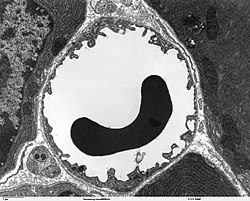Capillary system
| Capillary Capillary vessel |
|
|---|---|

Transmission electron microscope image of a capillary with a red blood cell within the pancreas. The capillary lining consists of long, thin endothelial cells, connected by tight junctions.
|
|

A simplified illustration of a capillary network (lacking precapillary sphincters, which are not present in all capillaries).
|
|
| Details | |
| Identifiers | |
| Latin | vas capillare |
| Code | TH H3.09.02.0.02001 |
| TA | A12.0.00.025 |
| FMA | 63195 |
|
Anatomical terminology
[]
|
|
Capillaries (/ˈkæpᵻlɛriz/ in US; /kəˈpɪləriz/ in UK) are the smallest of a body's blood vessels (and lymph vessels) that make up the microcirculation. Their endothelial linings are only one cell layer thick. These microvessels, measuring around 5 to 10 micrometres (µm) in diameter, connect arterioles and venules, and they help to enable the exchange of water, oxygen, carbon dioxide, and many other nutrients and waste substances between the blood and the tissues surrounding them. Lymph capillaries connect with larger lymph vessels to drain lymph collected in the microcirculation.
During early embryonic development new capillaries are formed through vasculogenesis, the process of blood vessel formation that occurs through a production of endothelial cells which then form vascular tubes. The term angiogenesis denotes the formation of new capillaries from pre-existing blood vessels and already present endothelium which divides.
...
Wikipedia
